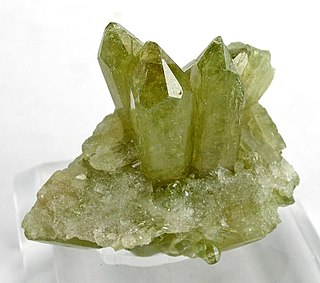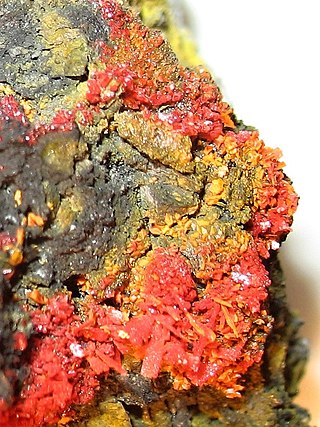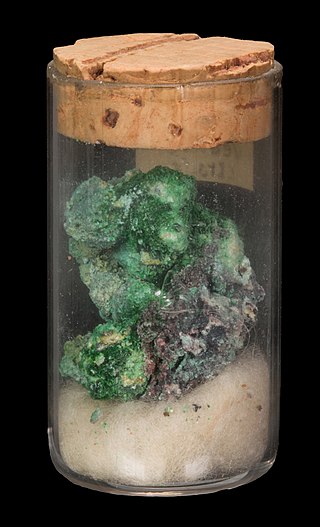
Sylvite, or sylvine, is potassium chloride (KCl) in natural mineral form. It forms crystals in the isometric system very similar to normal rock salt, halite (NaCl). The two are, in fact, isomorphous. Sylvite is colorless to white with shades of yellow and red due to inclusions. It has a Mohs hardness of 2.5 and a specific gravity of 1.99. It has a refractive index of 1.4903. Sylvite has a salty taste with a distinct bitterness.

Aphthitalite is a potassium sulfate mineral with the chemical formula: (K,Na)3Na(SO4)2.

Sellaite is a magnesium fluoride mineral with the formula MgF2. It crystallizes in the tetragonal crystal system, typically as clear to white vitreous prisms. It may be fibrous and occur as radiating aggregates. It has a Mohs hardness of 5 to 6 and a specific gravity of 2.97 to 3.15. Refractive index values are nω = 1.378 and nε = 1.390.

The scapolites are a group of rock-forming silicate minerals composed of aluminium, calcium, and sodium silicate with chlorine, carbonate and sulfate. The two endmembers are meionite and marialite. Silvialite (Ca,Na)4Al6Si6O24(SO4,CO3) is also a recognized member of the group.

Cotunnite is the natural mineral form of lead(II) chloride (PbCl2). Unlike the pure compound, which is white, cotunnite can be white, yellow, or green. The density of mineral samples spans range 5.3–5.8 g/cm3. The hardness on the Mohs scale is 1.5–2. The crystal structure is orthorhombic dipyramidal and the point group is 2/m 2/m 2/m. Each Pb has a coordination number of 9. Cotunnite occurs near volcanoes: Vesuvius, Italy; Tarapacá, Chile; and Tolbachik, Russia.

Tenorite, sometimes also called Black Copper, is a copper oxide mineral with the chemical formula CuO. The chemical name is Copper(II) oxide or cupric oxide.

Vesuvianite, also known as idocrase, is a green, brown, yellow, or blue silicate mineral. Vesuvianite occurs as tetragonal crystals in skarn deposits and limestones that have been subjected to contact metamorphism. It was first discovered within included blocks or adjacent to lavas on Mount Vesuvius, hence its name. Attractive-looking crystals are sometimes cut as gemstones. Localities which have yielded fine crystallized specimens include Mount Vesuvius and the Ala Valley near Turin, Piedmont.

Challacolloite, KPb2Cl5, is a rare halide mineral. It crystallizes in the monoclinic system (with space group P21/c) and occurs as white fumarolic encrustations on lava. It occurs as intergrowths with cotunnite.

Carpathite is a very rare hydrocarbon mineral, consisting of exceptionally pure coronene (C24H12), a polycyclic aromatic hydrocarbon. The name has been spelled karpatite and the mineral was improperly renamed pendletonite.

Portlandite is a hydroxide-bearing mineral typically included in the oxide mineral class. It is the naturally occurring form of calcium hydroxide (Ca(OH)2) and the calcium analogue of brucite (Mg(OH)2).

Magnesioferrite is a magnesium iron oxide mineral, a member of the magnetite series of spinels. Magnesioferrite crystallizes as black metallic octahedral crystals. It is named after its chemical composition of magnesium and ferric iron. The density is 4.6 - 4.7, and the diaphaniety is opaque. Occurs as well-formed fine sized crystals or massive and granular. Its hardness is 6-6.5. It has a metallic luster and a dark red streak.

Åkermanite (Ca2Mg[Si2O7]) is a melilite mineral of the sorosilicate group, containing calcium, magnesium, silicon, and oxygen. It is a product of contact metamorphism of siliceous limestones and dolomites, and rocks of sanidinite facies. Sanidinite facies represent the highest conditions of temperature of contact metamorphism and are characterized by the absence of hydrous minerals. It has a density of 2.944 g/cm3. Åkermanite ranks a 5 or 6 on the Mohs scale of mineral hardness, and can be found gray, green, brown, or colorless. It has a white streak and a vitreous or resinous luster. It has a tetragonal crystal system and a good, or distinct, cleavage. It is the end member in a solid solution series beginning with gehlenite (Ca2Al[AlSiO7]).

Alacránite (As8S9) is an arsenic sulfide mineral first discovered in the Uzon caldera, Kamchatka, Russia. It was named for its occurrence in the Alacrán silver/arsenic/antimony mine. Pampa Larga, Chile. It is generally more rare than realgar and orpiment. Its origin is hydrothermal. It occurs as subhedral to euhedral tabular orange to pale gray crystals that are transparent to translucent. It has a yellow-orange streak with a hardness of 1.5. It crystallizes in the monoclinic crystal system. It occurs with realgar and uzonite as flattened and prismatic grains up to 0.5 mm across.

Alum-(K) is a hydrous potassium aluminium sulfate mineral with formula KAl(SO4)2·12(H2O). It is the mineral form of potassium alum and is referred to as potassium alum in older sources. It is a member of the alum group.

Bassanite is a calcium sulfate mineral with formula CaSO4·1/2H2O or 2CaSO4·H2O. In other words it has half a water molecule per CaSO4 unit, hence its synonym calcium sulfate hemihydrate.
Urusovite is a rare copper aluminium arsenate mineral with formula: CuAlAsO5. It is a monoclinic-prismatic light green mineral.

Picromerite is a mineral from the class of hydrous sulfates lacking additional anions, and containing medium to large cations according to the Nickel–Strunz classification.

Euchlorine (KNaCu3(SO4)3O) is a rare emerald-green sulfate mineral found naturally occurring as a sublimate in fumaroles around volcanic eruptions. It was first discovered in fumaroles of the 1868 eruption at Mount Vesuvius in Campania, Italy by Arcangelo Scacchi. The name 'euchlorine' comes from the Greek word εΰχλωρος meaning "pale green" in reference to the mineral's color, other reported spellings include euclorina, euchlorin, and euchlorite.

Fumarole minerals are minerals which are deposited by fumarole exhalations. They form when gases and compounds desublimate or precipitate out of condensates, forming mineral deposits. They are mostly associated with volcanoes following deposition from volcanic gas during an eruption or discharge from a volcanic vent or fumarole, but have been encountered on burning coal deposits as well. They can be black or multicoloured and are often unstable upon exposure to the atmosphere.
Aleutite is both a vanadate and arsenate mineral but it can also be considered as a natural salt-inclusion phase that was first discovered at Second scoria cone of the Great Fissure Tolbachik eruption in the summer of 2015 in Kamchatka, Russia. Aleutite is a fumarolic mineral found with many other newly discovered minerals at this location. It gained the name from the Aleuts, the ethnic group who are the original inhabitants living on the Commander Islands, Aleutsky District, Kamchatka Krai. This mineral is very brittle and has a dark red color. Aleutite is a new structure type, the structure was refined as a 2-component twin, the twin ratio equals (0.955:0.045).


















